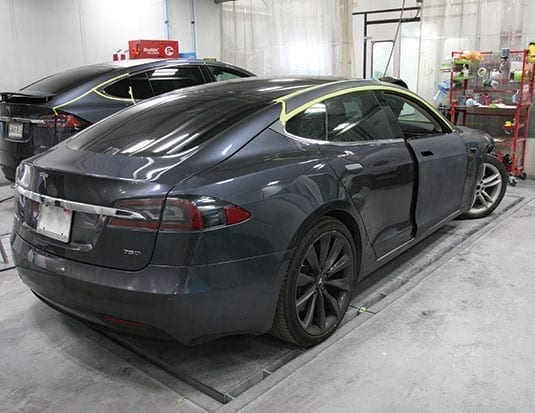How to prepare for a growing number of EVs entering collision shops.
Aided by fuel economy regulations, as well as government incentives, both provincial and federal, electric vehicles (EVs) have seen a significant growth in the Canadian automotive marketplace. And with some automakers declaring they will manufacture exclusively hybrid or pure electric vehicles in the future, understanding how to repair EVs following a crash is becoming more important. “Although government incentives are starting to be phased out, it is expected that by 2025, the cost of EVs will be similar to that of internal combustion engine (ICE) vehicles. At that point, we believe there will be a mass shift towards EVs,” says Michel Caron, Vice President of Sales, Dealer Fixed Operations and Collision Repair Solutions, Audatex.
Rising numbers
Speaking on the subject The Growth of Automotive Electrification and the Impact on the Collision Repair Industry, at the Canadian Collision Industry Forum (CCIF) 2019 in Toronto, Ryan Mandell, Director, Performance Consulting at Mitchell International presented statistics highlighting the growing numbers of electric vehicles on the road, both in Canada and around the world. According to a study by Bloomberg’s New Energy Finance department, electric vehicles will constitute 55% of all new vehicle sales by 2040.
Additionally, 33% of all vehicles on the road globally will be electric.
Comparing sales data of the third quarters of 2016 and 2017, Mandell pointed out that electric vehicle sales showed a 166% increase. In 2017, the total sales of electric vehicles had crossed one million units for the first time since their introduction.
Reasons for sales increases
Besides incentives, cost of fuel, commitment required towards regular maintenance and fuel efficiency there are additional developments that are fueling the increase in EV purchases. A significant one is range anxiety. Half a decade ago range anxiety was a serious issue for battery electric vehicles due to lower battery capacity. Automakers have since invested heavily in developing more efficient, albeit bigger, capacity battery sytems that allow electric vehicles to travel up to 300 km. The increasing number of charging stations, as well as better distribution, has also helped boost sales.
Mandell pointed out that over 1000 charging stations were installed in Canada in 2018. He further added that maintenance costs of electric vehicles are considerably lower than traditional ICE vehicles. A typical ICE vehicle has about 10,000 moving parts, whereas an electric vehicle has about 150. Subsequently, there is a reduction of parts that wear out and would ultimately lead to a reduction in lifetime cost of ownership. Additionally, the current cost of charging a vehicle is 50% less than fueling an ICE vehicle.

What should the industry expect?
Greater complexity in engineering EVs means greater complexity in repairing them.
“One of the most important components of today’s electric vehicles are the batteries. The focus continues to be on protecting them with higher strength steels and various other composite materials. Technicians are going to need training for handling these new substrates and also realize that more and more of these parts are going to have to be replaced in their entirety,” explains Wayne Krause, Manager of Editorial Content at Mitchell International.
Electric vehicles are some of the biggest consumers of advanced materials such as ultra-high strength steel, aluminum, carbon fibre, magnesium and even titanium. There are several restrictions on handling and repairing these materials. Understanding the proper and safe method of repairing these vehicles is critical for the collision industry.
Factors to consider
According to Michel Caron at Audatex, the actual repair procedures for EVs aren’t hugely different to traditional cars and light trucks. Yet because of the high voltage electrical systems EVs employ, he recommends that shop techicians wear protective gloves throughout the process and follow the safety measures listed below:
- Batteries must be de-energized prior to towing
- Towing must be performed without drive wheel rotation
- Scanning must confirm there are no HV system error codes
- The HV system must be fully disabled and verified using a multimeter before the teardown.
- HV connectors must be protected from fluids, dirt and other contaminants
- Follow the proper power-up sequence during the reassembly process
Extreme caution should also be exercised during the refinish process when repairing electric vehicles. “Per OE recommendations, the baking temperature limitation on electric vehicles is a maximum of 49 degrees Celsius (120 Fahrenheit). Therefore, shops need to work with their paint manufacturer to select the appropriate products for these repairs,” explains Caron.
Craig Van Batenburg, who owns and operates Automotive Career Development Center (ACDC) in Worcester, Mass., further recommends that the vehicle be kept for no longer than 30 minutes in the paint spray booth. Several electric vehicles require the battery to be removed completely during the refinish process. This means additional training and labour when working on these vehicles.
Industry professionals continuously stress the importance of stricly adhering to OEM procedures to perform proper and safe repairs while simultaneously ensuring repairers and the shop environment remain safe as well. Krause warns that there are no shortcuts to fixing an automobile correctly, and nowhere is this more evident than when dealing with high voltage electrical systems found on the latest EVs.
Investing for the future
Currently, many collision repair shops need to make some infrastructure adjustments in order to repair electric vehicles on a regular basis. “When the big battery has to be removed, it requires a special table with wheels and a special fixture to hold it,” says Craig Van Batenburg. “Since the battery is big and heavy, the collision centre has to set aside a place to store it when removed.” Van Batenburg suggests to make arrangements to get paid by the insurance company every day that the battery is stored in the shop. He also feels installing an on-site EV charging station is another sound strategy. Doing so will enable motorists to collect a repaired, fully charged vehicle, minimizing any potential range anxiety issues on the drive home.
At CCIF Toronto in 2019, Mitchell’s Ryan Mandell highlighted the fact that electric vehicles require the heaviest amount of investment in equipment and training. Collision shops would need to invest in special equipment just to be able to weld the different types of substrates used in their body structures. Additionally, Mandell noted the cost of materials and parts of these vehicles tends to be greater than for ICE vehicles, up to 38% greater in some cases.
In order to refinish EVs properly, Michel Caron says that collision shops may also have to replace a traditional paint booth with a short-wave electric infrared (IR) curing system.
Beyond new repair procedures and safety considerations, collision shops must also ensure their technicians are current and up-to-date with the latest repair procedures and understand the importance of following them. A must investment for all shops is training all repair technicians and them up-to-date with the latest OEM procedures and repair techniques.
The collision industry is looking at a future where there will likely be fewer opportunities to repair electric vehicles, due to lower maintenance needs, but higher costs. Since EVs are expected to continue growing in market share, shops need to be prepared to fix them.


